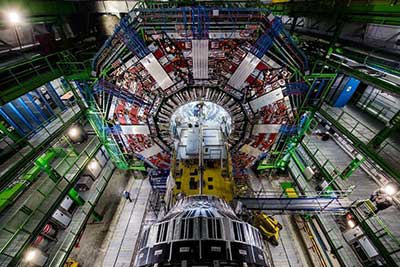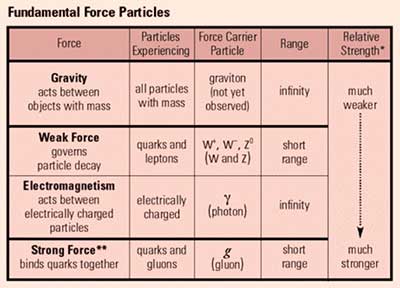Relevance: GS-3: Science and Technology- Developments and their applications and effects in everyday life.
Key Phrases: Large Hadron Collider, God Particle, Higgs boson, Fundamental particle, Higgs field, Peter Higgs and Satyendra Nath Bose, CERN, Dark matter, Proton therapy, Positron emission tomography.
Why in News?
- Scientists working with the Large Hadron Collider in Switzerland, announced the discovery of the Higgs boson, or the ‘God Particle’.
What is a God Particle or Higgs boson Particle?
- The Higgs boson is the fundamental particle associated with the Higgs field, a field that gives mass to other fundamental particles such as electrons and quarks.
- A particle’s mass determines how much it resists changing its speed or position when it encounters a force.
- Not all fundamental particles have mass.
- The photon, which is the particle of light and carries the electromagnetic force, has no mass at all.
- Scientists playfully refer to the Higgs boson as the ‘God Particle’, because it is one that is responsible for creation. For things to exist as real, they have to have ‘mass’, or ‘matter’.
- This particle is theoretically responsible for mass, without which there would be no gravity and no universe.
- The Higgs-boson was named after two scientists – Peter Higgs and Satyendra Nath Bose.
Do you know?
- Quark is a type of elementary particle and a fundamental constituent of matter.
- Quarks combine to produce composite particles called hadrons, the most stable of which are neutrons and protons that are the components of atomic nuclei.
- Leptons a subatomic particle, such as an electron, muon, or neutrino, which does not take part in the strong interaction.
- Gluon is an elementary particle that acts as the exchange particle (or gauge boson) for the strong force between quarks.
- Discovery of the Higgs boson will confirm the mechanism by which all elementary particles acquire mass.
- Higgs boson is often called the “God particle,” after the title of Nobel physicist Leon Lederman’s The God Particle: If the Universe Is the Answer, What Is the Question? (1993), which contained the author’s assertion that the discovery of the particle is crucial to a final understanding of the structure of matter.
How was Higgs boson discovered?
- Physicist Peter Higgs predicted the Higgs boson in a series of papers between 1964 and 1966.
- The theory suggests particle masses are a consequence of elementary particles interacting with a field, dubbed the Higgs field.
- Its presence was a guess that arose from tomes of mathematics. The only way to make sure it actually exists was to make it in a lab, for seeing is believing.
- In 1989 the first experiment with a serious chance of discovering the Higgs boson began.
- The idea was to smash particles together with such high energy that a Higgs particle could be created in a 27 km long tunnel at CERN in Geneva, Switzerland — the largest electron-positron (a positron is almost identical to an electron but has opposite charge) collider ever built.
- It ran for 11 years, but its maximum energy turned out to be just 5% too low to produce the Higgs boson.
- Meanwhile, Tevatron had started taking data at Fermilab, close to Chicago. The Tevatron collided protons and antiprotons (nearly identical to protons but with opposite charge) with an energy five times higher than what was achieved in Geneva – surely, enough to make the Higgs.
- But proton-antiproton collisions produce a lot of debris, making it much harder to extract the signal from the data. In 2011, the Tevatron ceased operations – the Higgs boson escaped detection again.
- In 2010, the Large Hadron Collider (LHC) began colliding protons with seven times more energy than the Tevatron.
- Finally, on July 4 2012, two independent experiments at CERN had each collected enough data to declare the discovery of the Higgs boson.
- In the following year, Higgs and his collaborator François Englert won the Nobel prize “for the theoretical discovery of a mechanism that contributes to our understanding of the origin of mass of subatomic particles”.
What is a Large Hadron Collider?
- The Large Hadron Collider (LHC) is the world’s largest and most powerful particle accelerator.
- It first started up on 10 September 2008, and remains the latest addition to CERN’s accelerator complex.
- The LHC consists of a 27-kilometre ring of superconducting magnets with a number of accelerating structures to boost the energy of the particles along the way.
- With extremely powerful magnets that create a mind-boggling magnetic field, the machine can accelerate protons.
- The aim is to enable physicists to experiment with different theories
regarding particle physics, including
- Identify dark matter.
- Find evidence for string theory.
- Understand antimatter.
- Measuring the properties of the Higgs boson.
- Search for extra dimensions of space and microscopic black holes.
- Look for signs of unification of fundamental forces.
- Learn about the fundamental forces that have shaped the universe since the beginning of time and will determine its fate.
Why God particle is important?
- God particle is the first big step toward the understanding the properties of the Higgs field and why it has a non-zero average value.
- Discovery of Higgs field would explain why some fundamental particles have mass when the symmetries controlling their interactions should require them to be massless.
- It would also explain why the weak force has a much shorter range than the electromagnetic force.
- It should allow physicists to finally validate the last untested area of the Standard Model’s approach to fundamental particles and forces, guide other theories and discoveries in particle physics, and potentially lead to developments in “new” physics.
- Discovery of the Higgs boson will confirm the mechanism by which all elementary particles acquire mass. Without mass the universe would not have formed, there would be no life, there would be no electronics.
- The Higgs boson could be an exotic portal for finding solid proofs of dark matter.
India and CERN:
- The experiments at CERN to discover Universe’s secrets started in 1954.
- India joined the league in 1992. The experiments on the Higgs boson began only in 2010.
- The finding has been aided by researchers from
- Delhi University,
- Bhabha Atomic Research Centre,
- Panjab University,
- Tata Institute of Fundamental Research (TIFR) in Mumbai and
- Saha Institute of Nuclear Physics (SINP) in Kolkata.
- India has contributed in two major ways—providing instrumentation and human resource for data analysis.
- India in 2016 became an associate member of the European Organisation for Nuclear Research (CERN).
- Indian scientists have played a significant role in the A Large Ion Collider Experiment (ALICE) and Compact Muon Solenoid (CMS) experiments that led to the discovery of the Higgs Boson.
Higgs boson’s offshoots:
- While the world focusses on the Higgs boson, the particle accelerators
used to find the particle have done more good. Like
- Proton Therapy and Positron Emission Tomography (PET) scan are contributions of this accelerator-based research.
- Proton therapy treats cancer by focussing a beam of protons directly on the tumor, sparing the surrounding healthy tissue. The beam is delivered using a particle accelerator.
- PET capitalises on the technology behind detectors used in accelerator systems. In PET, radioactive substances are injected into the body. These are then absorbed by the cancerous tissue, which in turn emits particles that are detected by PET detectors.
Source: The Hindu BL
Mains Question:
Q. The proper understanding of the Higgs boson particle would be a giant leap for humanity. Elaborate.










